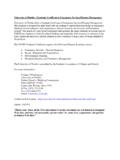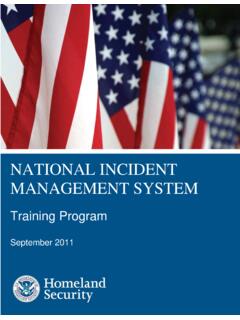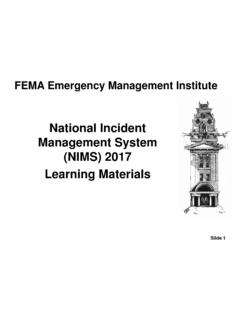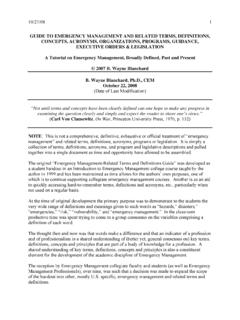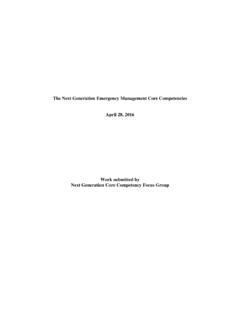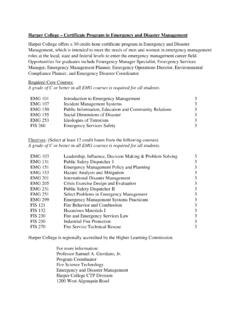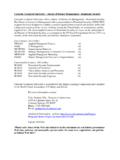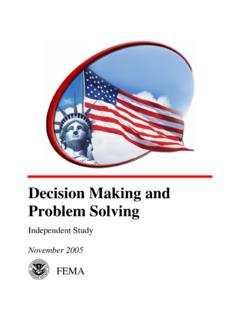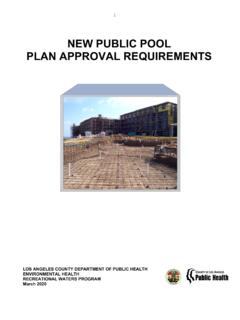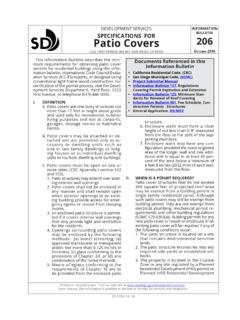Transcription of Chapter 7 Flood Damage Reduction Strategies and Tools
1 Flood Damage Reduction Strategies and Tools 7-1 Chapter 7 Flood Damage Reduction Strategies and Tools Chapter Overview The two primary goals of floodplain management are (1) Reduction of economic losses and threats to public health and safety from flooding, and (2) preservation and restoration of the natural and beneficial functions and resources within floodplains. Means of achieving the first goal is the focus of this Chapter . The second goal will be addressed in a subsequent Chapter . There are three basic Strategies that may be applied individually or in combination to reduce threats to life and property from flooding. They are: Modify the susceptibility to Flood Damage and disruption Modify the adverse impacts of floods on the individual and the community, and Modify floods Under each strategy there are a number of Tools that can be employed.
2 They are depicted in Figure 7-1. This Chapter will address these Strategies and Tools . Introduction At a period when the nation is particularly aware of allocating scarce resources among competing economic, environmental, and social needs, public and private decisions affecting floodplains must give explicit consideration to the hazards to life and property. Proposed solutions to Flood hazard problems must be evaluated in the context of all alternative Strategies and of the technical, financial, and legal capabilities of all affected parties to carry out their responsibilities. Legislative and administrative policies frequently cite two approaches structural and nonstructural for adjusting to the Flood hazard. In this context, structural is usually intended to mean adjustments that modify the behavior of floodwaters through the use of measures such as dams, levees, and channel modifications.
3 Nonstructural is usually intended to include all other adjustments ( , land-use regulations, Flood insurance) in the way society acts when occupying or modifying a floodplain. Both structural and nonstructural Tools are used for achieving desired future floodplain conditions. As stated above, there are three basic Strategies that may be applied individually or in combination: (1) modifying the susceptibility to Flood Damage and disruption, (2) modifying (reducing) the adverse impacts of floods on the individual and the community, and (3) modifying the floods themselves. Because the land and water resources of the floodplain and the Flood -related problems and needs are highly varied, different Strategies must be used to achieve desired objectives in different settings. Within these Strategies are a large variety of options or Tools for enabling desired uses or changing the uses of the floodplain.
4 Each situation is different, but the basic objectives of floodplain management cannot be realized without also lowering the direct or indirect adverse Flood Damage Reduction Strategies and Tools 7-2 Management Strategies Flood Loss Reduction I. Modify Susceptibility to Flood Damage and Disruption A. Floodplain Regulations 1. Zoning Ordinances 2. Subdivision Regulations 3. Building Codes 4. Housing Codes 5. Sanitary and Well Codes 6. Other regulatory Tools B. Development and Redevelopment Policies 1. Services and Utilities 2. Land Rights, Acquisition, Open Space 3. Redevelopment and Urban Renewal 4. Evacuation/Relocation C. Disaster Preparedness, Assistance, and Recovery D. Floodproofing E. Flood Forecasting and Warning/Emergency Plans II. Modify the Impact of Flooding on Individuals and the Community A.
5 Information and Education B. Flood Insurance C. Tax Adjustments D. Flood Emergency Measures E. Post- Flood Recovery III. Modify Flooding A. Dams, Reservoirs B. Dikes, Levees, Floodwalls C. Channel Alterations D. High-Flow Diversions and Spillways E. Land Treatment F. Onsite Detention G. Shoreline Protection Measures Figure 7-1. Flood loss Reduction management Strategies . Flood Damage Reduction Strategies and Tools 7-3 impacts of Flood losses on the individual and the community to an acceptable level. In almost every community, some combination of Strategies and Tools is required to achieve the desired management objectives. Although these Strategies and associated Tools for floodplain management may be used to guide public and private decision makers, there is a prerequisite and perhaps less obvious challenge, that of understanding the overall area s needs and goals.
6 Meeting this challenge requires formulation of assumptions about the future development of the area and region as well as sensitivity to impacts beyond the immediate consequences of an action. For example, in the past, Flood -modifying works frequently failed to account for indirect social costs ( , displacement) and environmental resources destroyed, although both represent costs passed on to the public. In recent decades there has been a trend toward increased reliance on nonstructural measures and less reliance on structural measures to address Flood losses. It must be realized, however, that some degree of Flood loss potential remains, regardless of how carefully floodplain management programs are formulated. Appropriate selection from the following Strategies and Tools is predicated on these understandings.
7 Modify Susceptibility to Flood Damage and Disruption The strategy to modify susceptibility to Flood Damage and disruption consists of actions to avoid dangerous, uneconomic, undesirable, or unwise use of the floodplain. Responsibility for implementing such actions rests largely with the non-federal sector. These actions include restrictions in the mode and the time of day and/or season of occupancy; in the ways and means of access; in the pattern, density and elevation of structures and in the character of their materials (structural strength, absorptiveness, solubility, corrodibility); in the shape and type of buildings and their contents; and in the appurtenant facilities and landscaping of the grounds. The strategy may also necessitate changes in the interdependencies between floodplains and surrounding areas not subject to flooding, especially interdependencies regarding utilities and commerce.
8 Implementing Tools for these actions include land use regulations, development and redevelopment policies, floodproofing, disaster preparedness and response plans, and Flood forecasting and warning systems. Land treatment measures, although discussed later in the strategy to Modify Flooding, can also function to modify susceptibility to Flood Damage . Different Tools may be more suitable to developed or underdeveloped floodplains or to more urban or rural areas. Floodplain Regulations1 Floodplain regulations are efficient Tools for modifying future susceptibility to Damage or loss, both on floodplains that are not fully developed and on highly developed floodplains where older structures are being rehabilitated. By providing direction to growth and change, regulations are particularly well-suited to preventing unwise floodplain occupancy.
9 Land use regulations require that individuals recognize the general welfare when making decisions. Legal treatment of floodplain regulations and their adoption will be addressed in a subsequent Chapter . A combination of regulatory Tools is necessary to control development in floodplains, and they are frequently utilized in combination with other techniques. Floodplain regulations which are part of broader land use regulations can be applied effectively only by state and community action. They are often required under ongoing federal programs ( , National Flood Insurance Program) as a prerequisite to other assistance. Administration of 1 Land-use regulations for floodplain management, introduced here, will be covered in greater detail in Chapter 15. Flood Damage Reduction Strategies and Tools 7-4 floodplain regulations adds only a small incremental cost where other ordinances are already being administered and these costs are characteristically small in relation to the Flood Damage problem.
10 To some degree, individual opportunity foregone is a cost of all land use regulations. The net economic cost, , reflecting externality costs, of reducing the intensity of use may be large or small. This cost depends on the availability of alternatives to a floodplain location. To be effective regulations must be based on sound and suitable technical data, must be equitably applied, and should permit reasonable use of the land (not necessarily highest economic return). Provisions have to be made to handle nonconforming uses, , construction or use that occurred before adoption of regulations and that now do not conform to the regulations. The regulatory aspects of floodplain management programs are sensitive to political pressures for change in favor of individuals, but they can be effective when equitably reinforced at all government levels.
